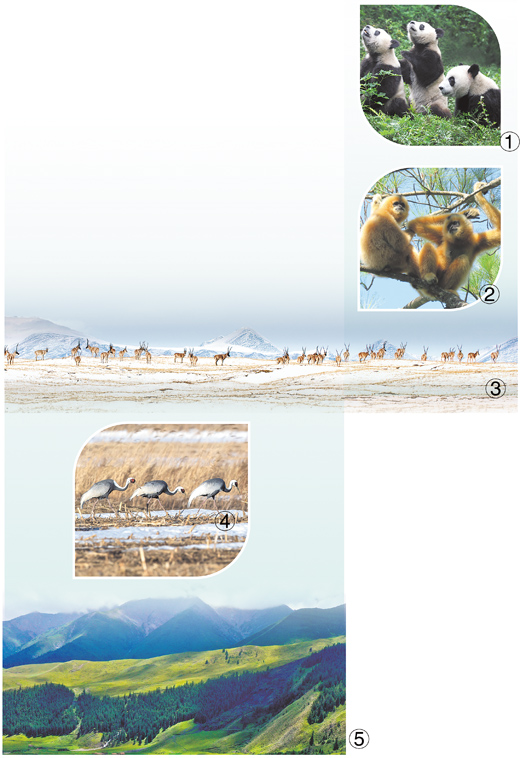China makes notable progress in protecting rare wild animals that call country home

① Photo shows three giant pandas at the Giant Panda National Park. (Photo courtesy of the National Forestry and Grassland Administration)
② Photo shows two Hainan gibbons at the Hainan Tropical Rainforest National Park in south China’s Hainan Province. (Photo courtesy of the National Forestry and Grassland Administration)
③ Photo shows Tibetan antelopes at the Sanjiangyuan National Park. (Photo courtesy of the National Forestry and Grassland Administration)
④ White-naped cranes forage at the Northeast China Tiger and Leopard National Park. (Photo courtesy of the National Forestry and Grassland Administration)
⑤ Photo shows a scene at the Qilian Mountain National Park. (People’s Daily/Wang Jiang)
China has made remarkable achievements in protecting wild animals in recent years through effective measures such as habitat conservation and artificial breeding. As a result, an increasing number of rare and endangered animals have been more frequently spotted in the country’s vast territory, and their populations have gradually risen.
The population of giant pandas in the wild has grown from 1,114 in the 1970s and 1980s to 1,864, while the number of wild Asian elephants has increased from about 180 in 1985 to about 300.
The crested ibis population in the wild has risen from only seven in 1981, when they were first discovered, to over 6,000; while the number of wild Tibetan antelopes has climbed to over 300,000 from fewer than 70,000 at the end of the 1990s.
The number of Hainan gibbons, the world’s rarest primate, has increased to 36 in five families from fewer than 10 in the 1980s in south China’s Hainan Province.
The populations of Siberian tigers and Amur leopards at the Northeast China Tiger and Leopard National Park are following a steady upward trend, as the ecology in the national park continues improving, said Zhao Li, head of the national park’s administration bureau. Zhao introduced that 10 new tiger cubs were discovered since 2017, increasing the total population of Siberian tigers to about 50, and there were also seven newly spotted Amur leopard cubs, which adds up to a leopard population of about 60.
The populations of over 100 rare and endangered wild animals, including the crested ibis, Asian elephants, and Tibetan antelopes, have recovered in ever-greater numbers, according to an official with the Department of Wildlife Conservation under the National Forestry and Grassland Administration (NFGA).
In recent years, China has been developing a natural protected area (PA) system with a focus on national parks. The first group of national parks, including the Sanjiangyuan National Park and the Giant Panda National Park, have already been officially established. So far, the country has established close to 10,000 natural PAs of all types, covering about 18 percent of its total land area and bringing 90 percent of terrestrial ecosystems and 85 percent of key wild animal populations under effective protection.
China was the first in the world to propose and implement a red line system for ecological conservation, which stipulates that at least 25 percent of its land area shall be demarcated for ecological protection. The system has contributed to the conservation of rare and endangered species and their habitats.
“Providing a natural environment that sustains wild animals by strengthening habitat protection and establishing natural protected areas is the most important, economical and efficient way for biodiversity conservation,” said Jiang Zhigang, former executive deputy director of the Endangered Species Scientific Commission of China.
Meanwhile, China has launched campaigns to rescue and breed rare and endangered wildlife through ex-situ conservation.
At present, China has set up wildlife rescue and breeding centers and germplasm genetic banks. More than 400 rare and endangered wild animal species have benefited from artificial breeding. The giant pandas, crested ibis, Chinese forest musk deer, Francois’ leaf monkeys, and other artificially bred species have been successfully released into the wild. Przewalski’s horses and elks, once nowhere to be found in the wild, are now thriving.
China’s Ministry of Ecology and Environment (MEE) started to build a national biodiversity observation network in 2011, and has developed a database of biodiversity conservation and monitoring. The network can obtain more than 700,000 pieces of data every year. “These first-hand data reflect changes in species in key regions, providing technical support for China to assess the conservation status and threat factors of biodiversity and to respond with relevant measures and policies,” said Jing Xin, director of the biodiversity protection office of the MEE’s Department of Nature and Ecology Conservation.
Besides, China has protected rare and endangered wild animals with the strongest rule of law and the strictest possible law enforcement. Since 2012, China has promulgated and revised more than 20 laws and regulations pertinent to biodiversity conservation, including laws on the protection of wild animals, forestry, grassland, the environment, the Yangtze River, and biosecurity.
Biodiversity conservation is inseparable from broad social participation. In recent years, the MEE, the NFGA and other departments have carried out public awareness activities and the dissemination of knowledge on biodiversity. People’s awareness of ecological protection has been remarkably enhanced as a result of these efforts.
Moving forward, China will further protect rare and endangered wild animals and achieve harmony between man and nature.
An NFGA official noted that China will continue to protect 48 critically endangered wild animal species, including giant pandas, Siberian tigers, and Chinese pangolins, and their habitats over the 14th Five-Year Plan period. This year, the country will set up a new batch of national parks in its key ecological regions, including the Qinghai-Tibet Plateau and the basins of the Yangtze River and the Yellow River.
China will further enhance its protection efforts, ensure the safety of valuable and endangered species as well as their habitats, strengthen law enforcement and monitoring, and crack down on illegal practices, according to the NFGA.
In addition, the country will launch more publicity activities to raise public awareness for wild animal protection and guide the public to oppose illegal acts, so as to nurture a sound atmosphere for wildlife protection.
Photos
Related Stories
- Tianjin sees improved marine biodiversity
- Biodiversity improved in Zhenlai County, China's Jilin
- WWF calls for ambitious, consensual framework to halt biodiversity loss
- Rare black storks visit Juma river in Hebei
- Biodiversity in Yunnan pays off
- Biodiverse Yunnan sees rare "butterfly explosion"
- Tianjun county in NW China’s Qinghai makes notable progress in biodiversity protection
- Massive surge of butterflies seen in Yunnan
- Rare wild animals filmed in China's plateau province
- World Bank approves funds to promote biodiversity, carbon neutrality in Chinese cities
Copyright © 2022 People's Daily Online. All Rights Reserved.









